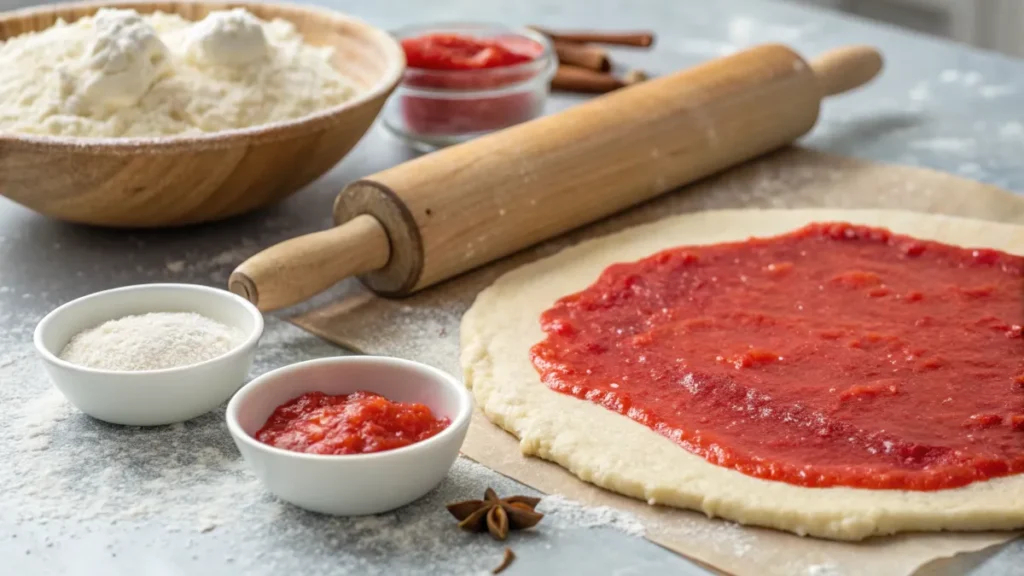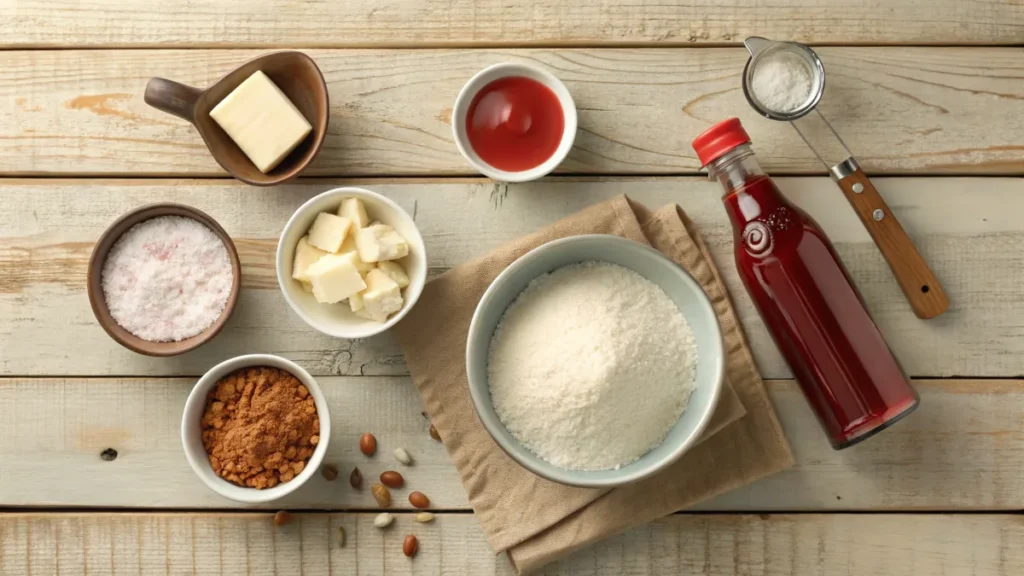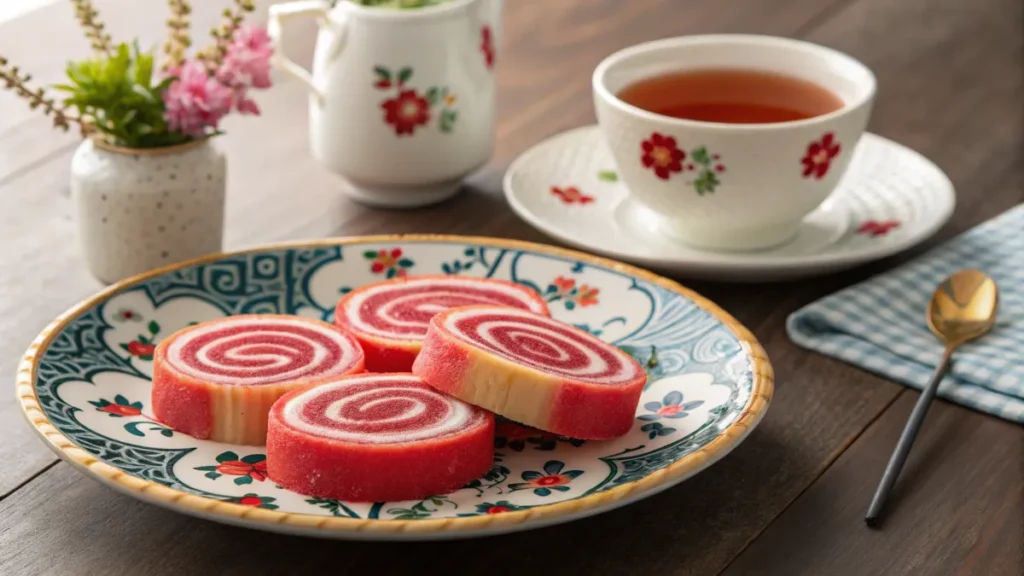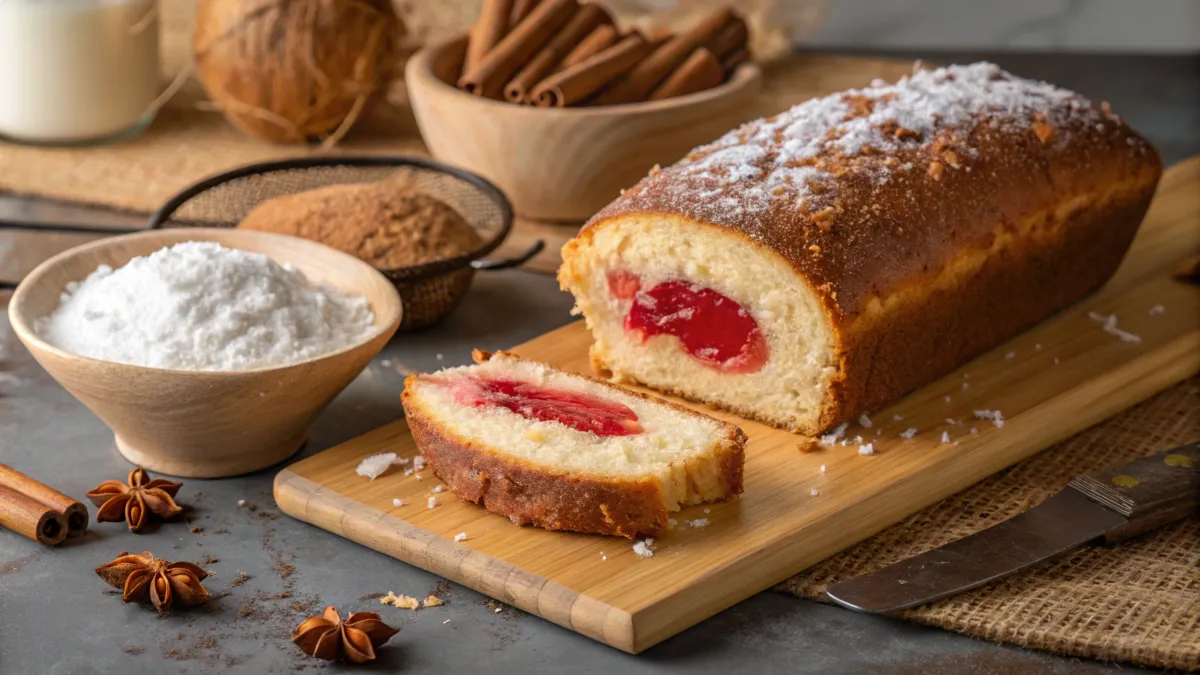Salara, a deliciously unique dessert, is much more than just a treat it’s a vibrant part of Guyanese culture. This soft bread roll, filled with sweet, red-tinted coconut, is not only pleasing to the taste buds but also reflects the heart of Guyana’s rich culinary traditions. In this article, we’ll explore the origins of Salara, how it’s made, and its role in Guyanese celebrations. You’ll also find a simple recipe and answers to frequently asked questions about this beloved dessert. Let’s dive in!
Salara
What is Salara?
Salara, often called red coconut roll, is a sweet bread roll that’s stuffed with a mixture of grated coconut, sugar, and spices. Its vibrant red filling, achieved with food coloring, makes it stand out. This dessert is a staple in Guyanese households and is loved for its soft, slightly buttery bread and flavorful filling. It’s commonly served as a snack or dessert and pairs perfectly with tea or coffee.
The Origins of Salara
The roots of Salara trace back to Guyana’s multicultural heritage. Guyanese cuisine blends African, Indian, and European influences, which shaped this delightful dessert. Salara was traditionally made for special occasions like weddings, birthdays, and festive gatherings. Its distinctive red color symbolizes joy and celebration, reflecting its importance in marking life’s happy moments.
The Making of Salara
Traditional Ingredients
Salara starts with simple ingredients. The dough combines flour, sugar, butter, milk, and yeast for a soft, slightly sweet bread. For the filling, freshly grated coconut is mixed with sugar, cinnamon, and nutmeg. This combination creates the sweet and aromatic core of the dessert. A small amount of food coloring gives the filling its signature red hue, which is both eye-catching and culturally meaningful.
Step-by-Step Preparation

To make Salara, you first prepare the dough by kneading it until smooth and letting it rise. Next, the coconut filling is prepared by mixing the grated coconut with sugar and spices, then adding food coloring for the vibrant red color. Once the dough has risen, it’s rolled out into a rectangle, the filling is spread evenly across, and the dough is rolled up tightly. After a final rise, it’s baked until golden brown and brushed with a sugar glaze for extra sweetness and shine.
The Role of the Signature Red Color
The bright red filling isn’t just for looks it holds symbolic meaning. In Guyanese culture, red is often associated with joy and celebration, making Salara a fitting treat for special occasions. The striking color also adds an element of festivity to any table.
Variations of Salara
Regional Twists in Guyana
While the traditional Salara recipe remains popular, variations exist across regions. Some bakers add dried fruits or nuts to the filling for extra texture and flavor. Others tweak the spice mix, incorporating ingredients like cardamom or cloves for a different taste. These regional adaptations showcase the creativity and resourcefulness of Guyanese cooks.
Modern Adaptations
Modern bakers have given Salara a contemporary spin. Gluten-free and vegan versions have gained popularity, making this classic dessert accessible to more people. Some cooks experiment with natural food colorings or swap out sugar for healthier alternatives like coconut sugar or honey. These adaptations maintain the spirit of Salara while catering to modern dietary preferences.
Salara in Guyanese Celebrations
Salara in Festivals and Gatherings
In Guyana, Salara takes center stage during special occasions. It’s often served at weddings, birthdays, and holiday festivities, symbolizing joy and togetherness. The dessert’s rich flavors and striking red filling make it a favorite treat for both kids and adults. Whether shared among family members or presented to guests, Salara brings warmth and sweetness to any celebration.
A Symbol of Community
Beyond its delightful taste, it fosters a sense of belonging. Families often gather to prepare the dessert together, passing down the recipe from one generation to the next. For Guyanese people living abroad, baking Salara is a cherished way to reconnect with their roots. Its preparation becomes an act of love, celebrating both tradition and the joy of sharing food.
Nutritional Value and Enjoyment
Calorie and Nutritional Breakdown
Though Salara is a dessert, it offers a balance of energy and nutrients. The bread provides carbohydrates for a quick energy boost, while the coconut filling adds fiber and essential fats. However, due to its sugar content, moderation is key to enjoying this treat as part of a balanced diet.
Pairing Salara with Beverages
Salara pairs beautifully with a variety of drinks. A warm cup of tea or coffee enhances the flavors of the coconut filling, while chilled beverages like milk or fruit juices provide a refreshing contrast. For a more traditional touch, try pairing it with a spiced Guyanese ginger beer, a popular choice during celebrations.
For more delicious recipes, check out other creative dinner ideas: Crescent Rolls and Rainy Day Dinner at Every Tastes.
FAQs About Salara
Salara stands out because of its bold red filling and rich coconut flavor. Unlike other desserts that may be overly sweet, Salara achieves the perfect balance of sweetness and spice. Its vibrant color and soft, swirled bread make it visually appealing, while the use of freshly grated coconut adds an authentic taste. This dessert is not just a treat but also a representation of Guyanese culinary artistry.
Absolutely! For those with dietary restrictions, there are plenty of ways to adapt Salara. To make it gluten-free, you can substitute all-purpose flour with a gluten-free blend that works well with yeast-based recipes. For a vegan version, swap the butter for plant-based margarine and use non-dairy milk alternatives. The filling can remain the same, as coconut and sugar are naturally vegan and gluten-free.
Authentic Salara can often be found at Guyanese bakeries or Caribbean grocery stores. Some specialty shops and online marketplaces also sell this delightful treat. However, nothing beats the joy of making Salara at home, where you can customize the flavors and enjoy it fresh out of the oven.
Recipe Section with Table
Simple Salara Recipe

Making Salara at home is easier than it seems. With a few basic ingredients and some patience, you can recreate this traditional treat. Here’s a quick recipe to get you started:
| Ingredient | Quantity |
|---|---|
| All-purpose flour | 3 cups |
| Sugar (for dough) | 1/4 cup |
| Butter | 2 tbsp |
| Warm milk | 1 cup |
| Yeast | 2 tsp |
| Grated coconut | 3 cups |
| Sugar (for filling) | 1 1/2 cups |
| Cinnamon | 1 tsp |
| Nutmeg | 1/2 tsp |
| Red food coloring | As needed |
Instructions:
- Combine warm milk, yeast, and sugar, and let it sit until frothy.
- Mix flour, butter, and the yeast mixture to form a soft dough. Let it rise for 1 hour.
- For the filling, mix grated coconut, sugar, cinnamon, nutmeg, and food coloring.
- Roll out the dough into a rectangle, spread the filling evenly, and roll it up tightly.
- Let it rise again for 30 minutes, then bake at 350°F (175°C) until golden brown. Brush with a sugar glaze for added shine.
For a more detailed guide to baking, explore other recipes for bread and desserts that you’ll love!
Related Topics and Conclusion
Exploring Guyanese Culinary Heritage
Guyanese cuisine is a vibrant blend of cultural influences. Dishes like pepper pot, roti, and the beloved Salara reflect the rich history of the nation. Each recipe showcases flavors drawn from African, Indian, and European traditions, making every meal a cultural experience. Salara stands out for its bold red coconut filling, symbolizing joy and celebration.
Beyond its delicious taste, it connects people with Guyanese traditions. By exploring other dishes like cassava pone, metage, or Guyanese patties, you can deepen your appreciation for the region’s culinary diversity. Every bite offers a journey through history, flavor, and tradition.
Final Thoughts on Salara
Salara is not just a dessert it’s a piece of Guyanese heritage. Its soft, sweet bread and vibrant filling are more than pleasing to the palate; they tell a story of love and community. Whether it’s shared during festive gatherings or enjoyed as an everyday treat, it brings people together.
Baking Salara at home allows you to create a connection with Guyanese culture. As you knead the dough and spread the coconut filling, you’re participating in a timeless tradition. The joy of sharing this dessert with loved ones makes the effort worthwhile. Salara is a reminder that food is more than sustenance it’s a celebration of life, love, and heritage.
Acknowledging the Importance of Tradition
Why Preserving Recipes Like Salara Matters
Recipes like Salara play an essential role in keeping cultural traditions alive. They are more than ingredients and steps; they are memories, stories, and a sense of identity passed from one generation to the next. In a rapidly changing world, preserving these recipes ensures that future generations remain connected to their roots.
Making Salara is more than baking it’s an act of cultural preservation. When you prepare this dish, you honor the efforts of those who came before you and keep their traditions alive.
Sharing Salara with the World

Sharing Salara is a wonderful way to introduce others to the warmth and richness of Guyanese culture. Whether it’s brought to a family gathering, given as a gift, or made for a holiday party, Salara sparks interest and delight. Its bold red color and sweet coconut filling make it stand out, creating a memorable experience for anyone who tries it.
Every time Salara is shared, it serves as a cultural ambassador, telling the story of Guyana and its culinary heritage. By preserving and sharing this recipe, you contribute to celebrating and honoring a tradition that deserves a global spotlight. Let Salara remind us of all of the joy that comes from keeping culture alive through food.
Tips for Perfecting Your Salara
Common Mistakes and How to Avoid Them
Even though it is simple to make, some common errors can occur. Overworking the dough can make the bread too dense, so knead it gently. Failing to evenly spread the filling can result in uneven flavor, so take your time to ensure every corner is covered. Lastly, adding too much food coloring can lead to an overpowering taste, so use just enough for a vibrant red hue.
Pro Tips for Beginners
For those new to baking, don’t be afraid to start with small batches to perfect your technique. Using freshly grated coconut will enhance the flavor significantly. If you’re short on time, pre-made dough can be a lifesaver without sacrificing quality. Finally, always allow your Salara to cool completely before slicing it helps keep the rolls intact and the filling from spilling out.
Conclusion
Salara is more than a dessert it’s a symbol of Guyanese culture, tradition, and love. This vibrant red coconut roll captures the heart and flavors of Guyana, making it a cherished treat for many. Whether you’re making it for the first time or rekindling old memories, Salara offers a beautiful way to connect with family, friends, and heritage.
By preserving recipes like Salara and sharing them, we keep traditions alive and introduce others to the richness of Guyanese cuisine. From its humble ingredients to its show-stopping appearance, it is a dessert that truly embodies the spirit of joy and togetherness.
Now it’s your turn to try making Salara at home. Share this recipe, savor the process, and enjoy the sweet rewards of this delightful treat. Happy baking!

